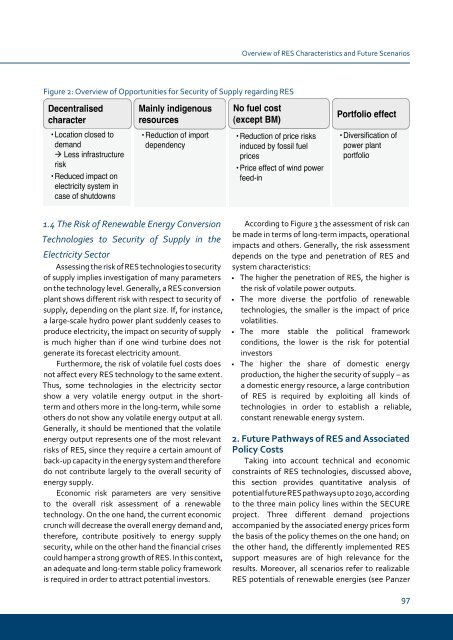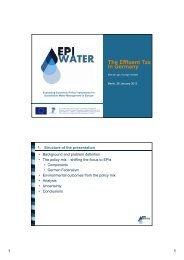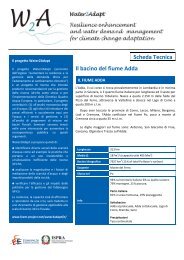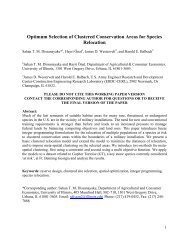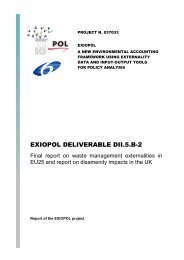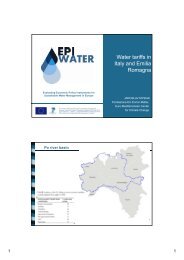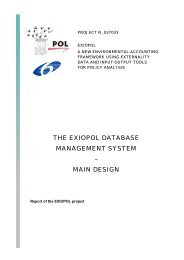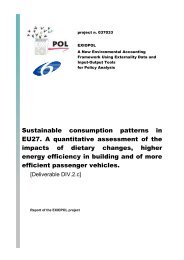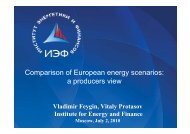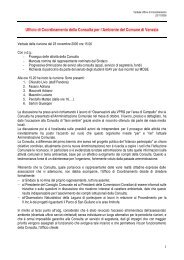Gulf and European Energy Supply Security - Feem-project.net
Gulf and European Energy Supply Security - Feem-project.net
Gulf and European Energy Supply Security - Feem-project.net
You also want an ePaper? Increase the reach of your titles
YUMPU automatically turns print PDFs into web optimized ePapers that Google loves.
Figure 2: Overview of Opportunities for <strong>Security</strong> of <strong>Supply</strong> regarding RES<br />
Decentralised<br />
character<br />
• Location closed to<br />
dem<strong>and</strong><br />
Less infrastructure<br />
risk<br />
• Reduced impact on<br />
electricity system in<br />
case of shutdowns<br />
Mainly indigenous<br />
resources<br />
• Reduction of import<br />
dependency<br />
1.4 The Risk of Renewable <strong>Energy</strong> Conversion<br />
Technologies to <strong>Security</strong> of <strong>Supply</strong> in the<br />
Electricity Sector<br />
Assessing the risk of RES technologies to security<br />
of supply implies investigation of many parameters<br />
on the technology level. Generally, a RES conversion<br />
plant shows different risk with respect to security of<br />
supply, depending on the plant size. If, for instance,<br />
a large-scale hydro power plant suddenly ceases to<br />
produce electricity, the impact on security of supply<br />
is much higher than if one wind turbine does not<br />
generate its forecast electricity amount.<br />
Furthermore, the risk of volatile fuel costs does<br />
not affect every RES technology to the same extent.<br />
Thus, some technologies in the electricity sector<br />
show a very volatile energy output in the shortterm<br />
<strong>and</strong> others more in the long-term, while some<br />
others do not show any volatile energy output at all.<br />
Generally, it should be mentioned that the volatile<br />
energy output represents one of the most relevant<br />
risks of RES, since they require a certain amount of<br />
back-up capacity in the energy system <strong>and</strong> therefore<br />
do not contribute largely to the overall security of<br />
energy supply.<br />
Economic risk parameters are very sensitive<br />
to the overall risk assessment of a renewable<br />
technology. On the one h<strong>and</strong>, the current economic<br />
crunch will decrease the overall energy dem<strong>and</strong> <strong>and</strong>,<br />
therefore, contribute positively to energy supply<br />
security, while on the other h<strong>and</strong> the financial crises<br />
could hamper a strong growth of RES. In this context,<br />
an adequate <strong>and</strong> long-term stable policy framework<br />
is required in order to attract potential investors.<br />
Overview of RES Characteristics <strong>and</strong> Future Scenarios<br />
No fuel cost<br />
(except BM)<br />
• Reduction of price risks<br />
induced by fossil fuel<br />
prices<br />
• Price effect of wind power<br />
feed-in<br />
Portfolio effect<br />
• Diversification of<br />
power plant<br />
portfolio<br />
According to Figure 3 the assessment of risk can<br />
be made in terms of long-term impacts, operational<br />
impacts <strong>and</strong> others. Generally, the risk assessment<br />
depends on the type <strong>and</strong> pe<strong>net</strong>ration of RES <strong>and</strong><br />
system characteristics:<br />
• The higher the pe<strong>net</strong>ration of RES, the higher is<br />
the risk of volatile power outputs.<br />
• The more diverse the portfolio of renewable<br />
technologies, the smaller is the impact of price<br />
volatilities.<br />
• The more stable the political framework<br />
•<br />
conditions, the lower is the risk for potential<br />
investors<br />
The higher the share of domestic energy<br />
production, the higher the security of supply – as<br />
a domestic energy resource, a large contribution<br />
of RES is required by exploiting all kinds of<br />
technologies in order to establish a reliable,<br />
constant renewable energy system.<br />
2. Future Pathways of Res <strong>and</strong> Associated<br />
Policy Costs<br />
Taking into account technical <strong>and</strong> economic<br />
constraints of RES technologies, discussed above,<br />
this section provides quantitative analysis of<br />
potential future RES pathways up to 2030, according<br />
to the three main policy lines within the SECURE<br />
<strong>project</strong>. Three different dem<strong>and</strong> <strong>project</strong>ions<br />
accompanied by the associated energy prices form<br />
the basis of the policy themes on the one h<strong>and</strong>; on<br />
the other h<strong>and</strong>, the differently implemented RES<br />
support measures are of high relevance for the<br />
results. Moreover, all scenarios refer to realizable<br />
RES potentials of renewable energies (see Panzer


